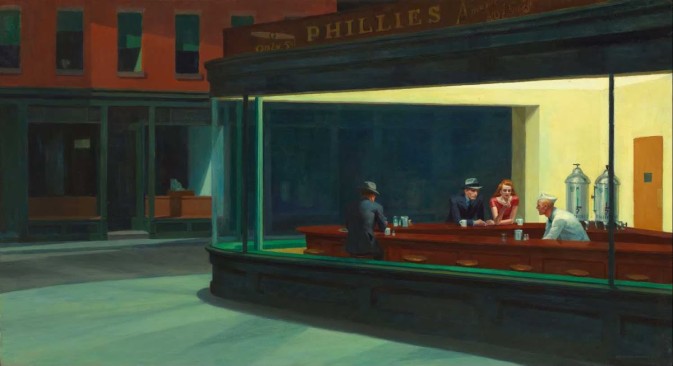
It could be extrange starts an article about Hopper talking about Munch. But it has explanation. I always remembered a painting of Munch showing his unhappy sister Laura. A woman sit at left shows a lost look to the right. She is in foreground. A House behind her and at right the landscape. Many of the feature of Hopper paintings are here. Munch paintings was depressive due the politics circumstances, his family poverty and diseases. And he painted the most paradigmatic painting when we want to talk about human suffering. His extreme expressionism ends up with The Scream showing a complicated personality and died before the end of the Second World War feeling fear to lose his painting by nazis who had invaded norway four years before.
Edward  Hopper is quite known painter. Then, it is not necessary to say so much about his biography. He has a very easy life and could works without money troubles. He married with Josephine Nivison, another painter, who devoted all her life to him, despite her own artist interest. How could Hopper pulls off so much complicated painting from his soul?. Is there any modern painter more deeply, psychologically, speaking than Edward Hopper?
Hopper is quite known painter. Then, it is not necessary to say so much about his biography. He has a very easy life and could works without money troubles. He married with Josephine Nivison, another painter, who devoted all her life to him, despite her own artist interest. How could Hopper pulls off so much complicated painting from his soul?. Is there any modern painter more deeply, psychologically, speaking than Edward Hopper?
That kind of feeling I feel when I see a Hopper painting, even when no human figure is painted you feel the presence of a man or woman with their existential weight into the soul. Even buildings seem to be thinking about something. But when explicitly their faces of human being are shown a number of reflections are sparked into yourself due the own vital experience as spectator. An paradigmatic example of it is shown in the picture called Nighthawks:

See two of the hawks. A couple. A man and a woman. By the way, she is a redhead woman as many of his women painted. It was so because Jo was his model, and obviously, she had a beautiful red hair. No words, not direct glances. He seems to be listening the waiter. Maybe not. But she is lost in her thoughts. Hands of both very close. May be it is the first date. A lonely man gives back to us (the spectators). What kind of thoughts are crossing his mind?. Is he in his own thoughts or the woman is waking up his desire?. Is very interesting read the Josephine’s description of this painting:
Night + brilliant interior of cheap restaurant. Bright items: cherry wood counter + tops of surrounding stools; light on metal tanks at rear right; brilliant streak of jade green tiles 3/4 cross canvas at base of glass of window curving at corner. Light walls, dull yellow ocre [sic] door into kitchen right. Very good looking blond boy in white (coat, cap) inside counter. Girl in red blouse, brown hair eating sandwich. Man night hawk (beak) in dark suit, steel grey hat, black band, blue shirt (clean) holding cigarette. Other figure dark sinister back at left. Light sidewalk outside pale greenish. Darkish red brick houses opposite. Picture of cigar. Outside of shop dark, green. Note: bit of bright ceiling inside shop against dark of outside street at edge of stretch of top of window.
Hopper’s biographer, Gail Levin, speculates that Hopper may have been inspired by Vincent Van Gogh’s Café at Night, which was showed at a gallery in New York in January 1942. In my opinion, there are two kind of Hopper’s painted persons. One is hearing his or her own thoughts or maybe a deeper level the own self feelings without words. Only the whole set of emotion coming from the inside as a summary of feelings. Obviously this is the foundation of the loneliness and isolation.

Moreover when you see a landscape painting of Hopper with buildings without any person, you can’t avoid the feeling that there is a not evident presence. Somebody caught by the beauty of the scene. Somebody fighting between the call of its feeling and the external brightness.



It is not quite known that Hopper made etchings. He was taught by Martin Lewis. Hopper optimize and shows a huge capability delivering very good outcomes as you can see.

